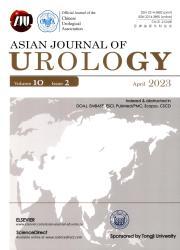精索静脉曲张切除术在伴有临床精索静脉曲张和孤立精子缺陷的不孕症患者中的作用
IF 2.4
3区 医学
Q2 UROLOGY & NEPHROLOGY
引用次数: 0
摘要
目的探讨显微外科腹股沟下精索静脉曲张切除术(MSV)对孤立性精子缺陷(少精症、弱精症、畸形精症)患者精液及激素参数的影响。方法回顾性分析哈马德医疗公司2011年1月1日至2019年1月1日因临床可触及精索静脉曲张接受MSV治疗的患者病历。所有在术前精液分析中被诊断为孤立性少精症、弱精症或畸形精症的患者均被纳入研究。排除有多个精子缺陷、遗传异常、无精子症、泌尿生殖系统感染史、化疗或放疗暴露、或术前接受过围手术期生育治疗的男性。从电子病历中提取的数据包括(在MSV之前和术后最多6个月收集):人口统计学(年龄)、临床资料(与生育有关的病史和手术干预)、家族史(血缘和不育)、全身和局部生殖器检查的体格检查结果(精索静脉曲张侧面和分级)、实验室资料(如精液分析、精子DNA片段检测、激素水平(促卵泡激素、促黄体生成素、总睾酮、雌二醇和催乳素)和影像学(阴囊彩色多普勒超声)。结果共纳入331例分离性精子缺陷患者。术后83.3%的患者精子浓度有所改善,中位数增加700万/mL。术后76.7%的分离性弱精子症患者总运动能力改善,66.0%的患者进行性运动能力改善,中位分别提高15.0%和7.5%。术后70.0%畸形精子患者的正常精子形态有所改善,平均增加6%。未观察到其他精液或激素参数的变化。结论msv是一种有效的治疗孤立性精子缺陷的方法,可明显纠正精子异常,提高自然受孕的机会。本文章由计算机程序翻译,如有差异,请以英文原文为准。
Role of varicocelectomy in infertile patients with clinical varicocele and isolated sperm defects
Objective
This study investigated the outcomes of microsurgical subinguinal varicocelectomy (MSV) on semen and hormonal parameters in cases with isolated sperm defects (oligozoospermia, asthenozoospermia, or teratozoospermia).
Methods
A retrospective review of charts of patients who underwent MSV for clinically palpable varicocele between January 1, 2011 and January 1, 2019 at Hamad Medical Corporation was undertaken. All patients diagnosed with isolated oligozoospermia, asthenozoospermia, or teratozoospermia in the preoperative semen analysis were included. Men with multiple sperm defects, genetic abnormalities, azoospermia, history of genitourinary infection, exposure to chemotherapy or radiotherapy, or prior use of peri-operative fertility treatment were excluded. Data extracted from the electronic medical records included (collected before MSV and up to 6 months postoperatively): demographics (age), clinical data (fertility-related medical history and surgical interventions), family history (consanguinity and infertility), physical examination findings from general and local genital exam (varicocele side and grade), laboratory data such as semen analysis, sperm DNA fragmentation tests, and hormone levels (follicle-stimulating hormone, luteinizing hormone, total testosterone, estradiol, and prolactin), and imaging (scrotal color Doppler ultrasound).
Results
A total of 331 patients with isolated sperm defects were included. Postoperatively, 83.3% of patients showed an improvement in sperm concentration with a median increase of 7 millions/mL. Postoperatively, 76.7% of isolated asthenozoospermic patients showed an improvement in total motility and 66.0% had an improvement in progressive motility with median increases of 15.0% and 7.5%, respectively. Postoperatively, 70.0% of the teratozoospermic patients showed an improvement in normal sperm morphology with a median increase of 6%. No changes were observed in other semen or hormone parameters that were examined.
Conclusion
MSV is a valid and effective treatment modality for patients with isolated sperm defects that significantly corrects their respective semen abnormality and improves their chances of natural conception.
求助全文
通过发布文献求助,成功后即可免费获取论文全文。
去求助
来源期刊

Asian Journal of Urology
UROLOGY & NEPHROLOGY-
CiteScore
4.00
自引率
3.80%
发文量
100
审稿时长
4 weeks
期刊介绍:
Asian Journal of Urology (AJUR), launched in October 2014, is an international peer-reviewed Open Access journal jointly founded by Shanghai Association for Science and Technology (SAST) and Second Military Medical University (SMMU). AJUR aims to build a communication platform for international researchers to effectively share scholarly achievements. It focuses on all specialties of urology both scientifically and clinically, with article types widely covering editorials, opinions, perspectives, reviews and mini-reviews, original articles, cases reports, rapid communications, and letters, etc. Fields of particular interest to the journal including, but not limited to: • Surgical oncology • Endourology • Calculi • Female urology • Erectile dysfunction • Infertility • Pediatric urology • Renal transplantation • Reconstructive surgery • Radiology • Pathology • Neurourology.
 求助内容:
求助内容: 应助结果提醒方式:
应助结果提醒方式:


